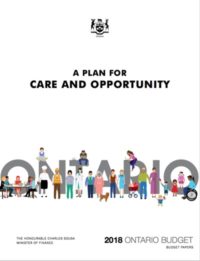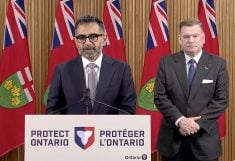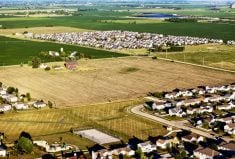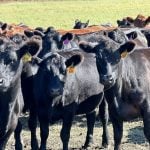The Ontario Liberal government’s 2018 budget was big on new spending on large programs for childcare and expansion of pharmacare, but quiet on agriculture.
Rural and remote regions of the province, however, will see a $500 million investment in broadband internet infrastructure over three years.
There’s a provincial election coming in June and the Wynne government is promising significant new spending and budget deficits until 2025, after one year of a budget surplus. Most of the budget items will only come into effect if the Liberals win the June election.
Why it matters: More years of budget deficits will continue to keep Ontario’s debt to Gross Domestic Product (GDP) ratio above 35 per cent.
The budget for the Ontario Ministry of Agriculture, Food and Rural Affairs will increase slightly, but there were no details available yet about where that money will be spent.

Keith Currie, president of the Ontario Federation of Agriculture (OFA), says the budget forecast deficits for six more years, which is concerning. It mentioned agriculture rarely, other than in the context of already-announced or trade, but Currie says there were some items that would benefit rural areas and farms.
- Almost $1 billion was promised for road infrastructure. While major highways like the 401, 417 and 427 were mentioned and will eat up much of the funds, “there may be some opportunities for money to go into rural infrastructure,” says Currie.
- The $500 million in broadband internet and cellular infrastructure is encouraging, says Currie. The provinces plans to spend $71 million of that money to expand cellular coverage in eastern Ontario.
The OFA is promoting its Producing Prosperity program ahead of the coming election, which encouraged long-term investments in rural infrastructure, which would also benefit farms.
Read Also

Canada seventh-most influential country on agri-food
Report from Dalhousie University and MNP shows Canada ranks seventh among G20 countries on agri-food influence.
Currie says he was disappointed by the lack of any mention of natural gas expansion in the province, a key request of the OFA. Farms and rural residents without access to natural gas pay more for alternatives like propane or heating oil, putting at a disadvantage those with everything from grain dryers to heated poultry barns.
The provincial government had mentioned natural gas in the previous four budgets, but hadn’t delivered on fulfilling the potential mentioned in the budgets. One program that totalled $100 million did help connect people and businesses already close to natural gas.
The government also said it would spend $11 billion on a new high speed rail corridor from Windsor to Toronto as part of a large 10-year infrastructure commitment. The high speed rail proposal is controversial in rural Ontario because of the roads it would cut off and farmland it would require.
Currie has been working on getting a meeting or call with new Progressive Conservative Leader Doug Ford, but it hasn’t come through yet.
The Liberal government’s base of support is in the cities, especially in the Toronto area, so many of budget proposals played to those constituents, including:
- Free licensed daycare for children from the age of two and a half until kindergarten.
- Seniors who, once they are 75 can access up to $750 for help with home maintenance. Seniors, over age 65 also get free presciptions.
- Welfare recipients will see their social assistance benefit rates rise three per cent each year.
- Ontario residents with no prescription drug or dental coverage will quality for a benefit worth $700 each year, for a family of four.
Taxes will also rise with the elimination of the Ontario personal income surtax. About 1.8 million taxpayers will pay higher rates, with $275 million more per year going to the province.















